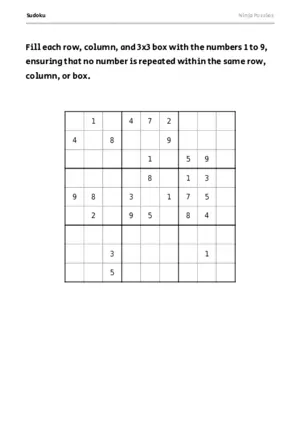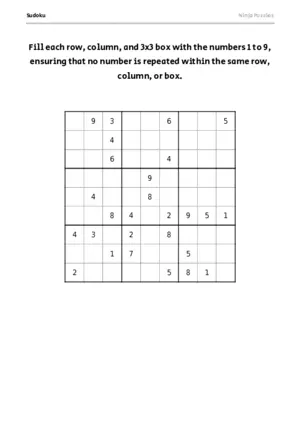Sudoku: Swordfish Strategy and Techniques
The Swordfish strategy is an advanced technique in Sudoku puzzle solving that can help you make deductions and narrow down possibilities. It is similar to the X-Wing strategy but expands the concept to three rows or three columns. By recognizing patterns where a number can only occur in the same three positions across these rows or columns, you can eliminate that number as a possibility in other squares within those rows or columns.
To use the Swordfish strategy, follow these steps:
- Analyze the puzzle and choose a specific number to focus on.
- Look for rows that contain the chosen number in two or more squares.
- Look for columns that contain the chosen number in two or more squares.
- Identify three rows where the chosen number appears in the same three positions and align with three columns where the number also appears in the same three positions. This forms a Swordfish pattern.
- Once you identify this pattern, eliminate the chosen number as a possibility from other squares within those rows or columns because it must appear in those specific positions of the Swordfish pattern.
- Update your puzzle and repeat these steps for other numbers, looking for additional Swordfish patterns.
Remember to practice and develop your ability to recognize these patterns efficiently. With experience, you’ll become faster at identifying Swordfish opportunities and making deductions using this strategy.
Mastering the Swordfish strategy requires practice and a keen eye for patterns. With experience, you’ll develop the ability to quickly identify Swordfish opportunities and make efficient deductions, which can significantly speed up the puzzle-solving process.
Sudoku Solver
If you get really stuck then we have an online Sudoku Solver, and a Sudoku Mini Solver to help you solve the most challenging Sudoku puzzles.
Advanced Sudoku Strategies
- Singleton Technique: This strategy involves identifying squares that have only one possible candidate number based on the numbers already present in the row, column, and box.
- Naked Pairs and Triples: When two or three squares in a unit (row, column, or box) have the same two or three candidate numbers, those numbers can be eliminated as possibilities from other squares in the unit.
- Hidden Pairs and Triples: This strategy focuses on identifying two or three candidate numbers that only appear in the same two or three squares within a unit. These numbers can then be eliminated as possibilities from other squares in the unit.
- Sudoku X-Wing: Sudoku X-Wing involves finding two rows or two columns where the same number can only occur in the same two positions. By eliminating that number as a possibility in the corresponding rows or columns, you can make further deductions.
- Swordfish: Similar to Sudoku X-Wing, Swordfish strategy expands the concept to three rows or three columns. It involves finding three rows or three columns where the same number can only occur in the same three positions, allowing for further eliminations.
- Sudoku Y-Wing: Sudoku Y-Wing is an advanced strategy that involves three cells and three numbers. By utilizing a specific pattern of candidate numbers, you can make deductions that lead to solving other squares.
- Sudoku XYZ-Wing: XYZ-Wing involves three cells and three numbers, with each number belonging to a different candidate list. It allows for deductions by creating chains of eliminations based on the relationships between the three numbers.
- Coloring: This strategy involves assigning colors (usually two) to candidates and using the relationships between these colors to make deductions.
- Backtracking: Backtracking is a brute-force technique that involves making educated guesses and trying different possibilities until a contradiction is reached or the puzzle is solved.








